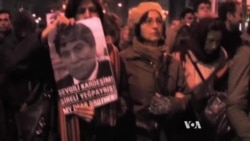In a climate of improved tolerance, growing numbers of people in Turkey are discovering their grandmothers were Armenian, and the revelations are being viewed as an important step.
Hundreds of thousands of Armenians escaped the mass deportations and slaughter of the early 1990's by forced conversion to Islam. Also, some Armenian children were taken in by Turkish families and assimilated. Their stories are now increasingly being heard.
It was Fethiye Cetin’s book "My Grandmother" that opened the door to one of Turkey's darkest chapters in its history. The book, as Cetin explains, documents her grandmother’s hidden life of being an Armenian orphan, that the grandmother only revealed when she was 70.
Adopted by Muslim family
Cetin says her grandmother experienced the carnage as the child of an Armenian family, that she made the long walk of death and arrived in the Cermik town of Diyarbakir and there she was taken in as an adopted daughter by a Muslim family.
"I wanted to break the silence," Cetin says. "She kept all the details in her memory alive. Her silence really touched me. I wanted to break this silence and share the truth I learned," she added.
Historians estimate that up to 200,000 Armenians, mainly children and some young women, survived the deportations and mass killings of 1915 and were assimilated into Muslim families. The publication in 2004 of Cetin’s book, which became a bestseller, helped many people acknowledge their Armenian roots.
The office of Agos, a bilingual Turkish Armenian newspaper, is one of the first places many people come looking for help in trying to discover the full story of their Armenian past. The paper publishes all inquiries about searches for relatives.
Agos chief editor Yetvart Danzikyan says it is a growing phenomenon.
"There is a new trend in Turkey to explore an Armenian grandmother. For example, when going to any conference in Anatolia or Ankara, always two or three person came and say that last year I learned my grandmother was an Armenian," Danzikyan says.
"Of course, she lived as a Muslim and died as a Muslim. And they say, my father and mother didn’t tell me. We know 200,000 Armenians must be a Muslim in genocide. More people face some stories and some realities which is in fact proof of genocide," he added.
It was the reaction to the murder of Agos founder Hrant Dink by a Turkish nationalist in 2007 that gave further impetus to people seeking to uncover their past, according to Pakrat Estukyan, editor of Agos' Armenian pages.
"Ten thousand people started walking from Taksim Square to Agos newspaper, shouting, 'We are all Hrant Dink and we are all Armenian," Estukyan says. "This was a slogan for solidarity. We all knew that not all the people walking there were Armenians. Nobody was aware of it at the time but this created a break in the political climate in Turkey."
Dink's funeral was one of the largest in Turkey's history.
Orphan stories
Documentaries are now being made of the lives of Armenian orphans, contributing to an opening up of the debate.
Cetin says the growing numbers of Armenian orphan stories coincide with important changes in society.
"The issue of converted Armenians has helped in talking about 1915 in a more open way." Cetin says. "The state is still insisting on denying the genocide. But, the society is very different, it is more dynamic more inquisitive. That's why I think the society is starting to change."
With Cetin’s grandmother's story continuing to be the inspiration for more families to uncover their stories of hidden Armenian ancestors, the hope is that legacy can offer a path for the country and people to reconcile themselves with their history.









